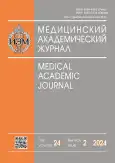Уровни мРНК генов миелинизации в спинном мозге крыс с нокаутом гена обратного захвата дофамина
- Авторы: Куликова Е.Д.1, Трактиров Д.С.1, Карпенко М.Н.1
-
Учреждения:
- Институт экспериментальной медицины
- Выпуск: Том 24, № 2 (2024)
- Страницы: 101-108
- Раздел: Оригинальные исследования
- Статья опубликована: 29.10.2024
- URL: https://journals.eco-vector.com/MAJ/article/view/630270
- DOI: https://doi.org/10.17816/MAJ630270
- ID: 630270
Цитировать
Полный текст
Аннотация
Обоснование. Синдром дефицита внимания и гиперактивности — одно из самых распространенных нервно-психических заболеваний у детей. Несмотря на большую социальную значимость данного синдрома, этиология заболевания не установлена. Одно из возможных звеньев патогенеза этого заболевания — нарушение миелинизации нервных волокон. Крысы с нокаутом гена транспортера дофамина (dopamine transporter gene knockout, DAT-KO) представляют наиболее распространенную модель синдрома дефицита внимания и гиперактивности, поскольку демонстрируют симптомы, сходные с таковыми у детей с заболеванием: повышенную двигательную активность, когнитивные нарушения и компульсивное поведение. Данная работа позволит определить наличие нарушений миелинизации в спинном мозге крыс линии DAT-KO, что расширит понимание этиологии и патогенеза синдрома.
Цель — определение уровня мРНК генов, кодирующих белки, участвующие в процессе миелинизации, в спинном мозге крыс DAT-KO при их естественном развитии.
Материалы и методы. Работа выполнена на 72 крысятах (DAT-KO, DAT-HET, DAT-WT), полученных в результате скрещивания 12 пар половозрелых крыс DAT-HET. Крысят декапитировали на 7, 14, 21-й дни постнатального развития, после чего в шейном и поясничном отделе спинного мозга методом обратной транскрипции полимеразной цепной реакции в реальном времени измеряли уровни мРНК основных генов-маркеров миелинизации.
Результаты. Уровни мРНК генов mag, olig2 и plp1 существенно отличались в шейном и поясничном отделах спинного мозга крыс DAT-KO по сравнению с животными DAT-WT. Значимое повышение уровня мРНК гена mag у животных DAT-HET и DAT-KO наблюдалось на 14-й и 21-й день постнатального развития. У этих животных также был повышен уровень мРНК гена olig2 на 21-й день постнатального развития. Уровень мРНК гена plp1 у животных DAT-KO был повышен на 14-й и понижен на 21-й день постанального развития.
Заключение. Нарушение миелинизации нервных волокон спинного мозга крыс DAT-KO — одно из последствий нокаута гена транспортера дофамина, а также одна из возможных причин наблюдаемых поведенческих изменений — гиперактивности, когнитивных нарушений и компульсивного поведения.
Ключевые слова
Полный текст
Об авторах
Екатерина Денисовна Куликова
Институт экспериментальной медицины
Email: kulikovaekaterina77@gmail.com
ORCID iD: 0009-0002-3218-1494
лаборант-исследователь физиологического отдела им. И.П. Павлова
Россия, Санкт-ПетербургДмитрий Сергеевич Трактиров
Институт экспериментальной медицины
Автор, ответственный за переписку.
Email: ds.traktirov@gmail.com
ORCID iD: 0000-0003-0424-6545
младший научный сотрудник физиологического отдела им. И.П. Павлова
Россия, Санкт-ПетербургМарина Николаевна Карпенко
Институт экспериментальной медицины
Email: mnkarpenko@mail.ru
ORCID iD: 0000-0002-1082-0059
SPIN-код: 6098-2715
д-р биол. наук, заведующая лабораторией нейрохимии физиологического отдела им. И.П. Павлова
Россия, Санкт-ПетербургСписок литературы
- Adinolfi A., Zelli S., Leo D., et al. Behavioral characterization of DAT-KO rats and evidence of asocial-like phenotypes in DAT-HET rats: The potential involvement of norepinephrine system // Behav Brain Res. 2019. Vol. 359. P. 516–527. doi: 10.1016/j.bbr.2018.11.028
- Bongarzone E.R., Howard S.G., Schonmann V., Campagnoni A.T. Identification of the dopamine D3 receptor in oligodendrocyte precursors: potential role in regulating differentiation and myelin formation // J Neurosci. 1998. Vol. 18, N 14. P. 5344–5353. doi: 10.1523/JNEUROSCI.18-14-05344.1998
- Howard S., Landry C., Fisher R., et al. Postnatal localization and morphogenesis of cells expressing the dopaminergic D2 receptor gene in rat brain: expression in non-neuronal cells // J Comp Neurol. 1998. Vol. 391, N 1. P. 87–98. doi: 10.1002/(sici)1096-9861(19980202)391:1<87::aid-cne8>3.0.co;2-n
- Choi M.H., Na J.E., Yoon Y.R., et al. Role of dopamine D2 receptor in stress-induced myelin loss // Sci Rep. 2017. Vol. 7, N 1. P. 11654. doi: 10.1038/s41598-017-10173-9
- Aberg K., Saetre P., Jareborg N., Jazin E. Human QKI, a potential regulator of mRNA expression of human oligodendrocyte-related genes involved in schizophrenia // Proc Natl Acad Sci USA. 2006. Vol. 103, N 19. P. 7482–7487. doi: 10.1073/pnas.0601213103
- Fan X., Bruno K.J., Hess E.J. Rodent models of ADHD // Curr Top Behav Neurosci. 2012. Vol. 9. P. 273–300. doi: 10.1007/7854_2011_121
- Pestereva N.S., Traktirov D.S., Nazarov I.R., et al. Influence of the DAT gene knockout on early rats development [abstract]. In: Proceedings of the 29th International Annual ISBS “Stress and Behavior” Neuroscience and Biological Psychiatry Conference. 18–19 May 2023. P. 23.
- Jones E.G., Schreyer D.J., Wise S.P. Growth and maturation of the rat corticospinal tract // Prog Brain Res. 1982. Vol. 57. P. 361–379. doi: 10.1016/S0079-6123(08)64137-0
- Cinque S., Zoratto F., Poleggi A., et al. Behavioral phenotyping of dopamine transporter knockout rats: compulsive traits, motor stereotypies, and anhedonia // Front Psychiatry. 2018. Vol. 9. P. 43. doi: 10.3389/fpsyt.2018.00043
- McKerracher L., David S., Jackson D.L., et al. Identification of myelin-associated glycoprotein as a major myelin-derived inhibitor of neurite growth // Neuron. 1994. Vol. 13, N 4. P. 805–811. doi: 10.1016/0896-6273(94)90247-x
- McKerracher L., Rosen K.M. MAG, myelin and overcoming growth inhibition in the CNS // Front Mol Neurosci. 2015. Vol. 8. P. 51. doi: 10.3389/fnmol.2015.00051
- Lu J., Lian G., Zhou H., et al. OLIG2 over-expression impairs proliferation of human Down syndrome neural progenitors // Hum Mol Genet. 2012. Vol. 21, N 10. P. 2330–2340. doi: 10.1093/hmg/dds052
- Marshall C.A., Novitch B.G., Goldman J.E. Olig2 directs astrocyte and oligodendrocyte formation in postnatal subventricular zone cells // J Neurosci. 2005. Vol. 25, N 32. P. 7289–7298. doi: 10.1523/JNEUROSCI.1924-05.2005
- Mayer J.A., Larsen E.C., Kondo Y., Duncan I.D. Characterization of a PLP-overexpressing transgenic rat, a model for the connatal form of Pelizaeus-Merzbacher disease // Neurobiol Dis. 2011. Vol. 44, N 2. P. 231–238. doi: 10.1016/j.nbd.2011.07.007
- Leo D., Sukhanov I., Zoratto F., et al. Pronounced hyperactivity, cognitive dysfunctions, and BDNF dysregulation in dopamine transporter knock-out rats // J Neurosci. 2018. Vol. 38, N 8. P. 1959–1972. doi: 10.1523/JNEUROSCI.1931-17.2018
- Narayan S., Kass K.E., Thomas E.A. Chronic haloperidol treatment results in a decrease in the expression of myelin/oligodendrocyte-related genes in the mouse brain // J Neurosci Res. 2007. Vol. 85, N 4. P. 757–765. doi: 10.1002/jnr.21161
- Savchenko A., Müller C., Lubec J., et al. The lack of dopamine transporter is associated with conditional associative learning impairments and striatal proteomic changes // Front Psychiatry. 2022. Vol. 13. P. 799433. doi: 10.3389/fpsyt.2022.799433
Дополнительные файлы









